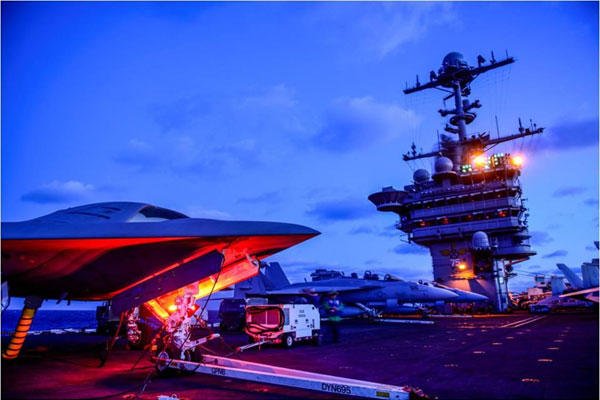The head of air warfare for the U.S. Navy said he's frustrated by a delay in the plan to build a fleet of drones aboard aircraft carriers.
Rear Adm. Michael Manazir, the service's director of air warfare, on Wednesday said he didn't know when exactly the Navy expects to solicit bids from companies to begin developing the so-called Unmanned Carrier Launched Airborne Surveillance and Strike System, or UCLASS.
"The UCLASS RfP has been ready to release now for over a year," he said, referring to a request for proposals to begin a competition for the weapons program. "We should have it on the street. We have lost this time to put that technology to work. That's where my frustration is."
The Navy had planned to solicit bids last year, but the acquisition effort was delayed until 2016 following questions from lawmakers and Pentagon officials about whether the drone would be stealthy enough to conduct both surveillance and strike missions as part of the carrier air wing, among other issues.
UCLASS Requirements
Speaking to reporters during a news conference on Capitol Hill to highlight budget shortfalls in the Navy and Marine Corps, Manazir said the program calls for a maritime-based unmanned platform capable of providing intelligence, surveillance and reconnaissance (ISR) along with the ability to strike targets.
"People talk about, 'Well, it's got to be ISR or it's got to be strike,'" he said. "We actually have a requirement that has all of those roles in our potential design."
Civilian experts such as Robert Martinage, a senior fellow at the Center for Strategic and Budgetary Assessments, a think tank in Washington, D.C., have described proposed specifications for the drone, such as the ability to stay aloft for 14 hours and carry an internal payload of up to 1,000 pounds, as inadequate and "off the mark."
The Navy now plans to begin the UCLASS competition after the Defense Department conducts a review of its aviation portfolio. After a two-month bid-selection process, the service will take about 10 months to select a winner or winners. It wants to deliver a carrier-based drone to the fleet by 2020.
Expanding on the X-47B
Four companies last year received contracts valued at $15 million to begin developing the UCLASS technology, including Boeing Co., General Atomics Aeronautical Systems Inc., Lockheed Martin Corp. and Northrop Grumman Corp., which built the experimental X-47B that in 2013 became the first unmanned system to take off from and land on an aircraft carrier.
In recent years, the X-47B conducted carrier deck operations and maneuvers with manned aircraft. In tests aboard the USS Theodore Roosevelt last year, the Navy launched and landed the craft in rapid succession with an F/A-18 fighter jet. After an eight-minute flight, the X-47B executed an arrested landing, folded its wings and taxied out of the landing area to make way for the fighter jet to touch down.
Manazir said the service is considering adding more funding for the X-47B program to demonstrate other concepts and technologies. The program already proved the potential of the airframe, communication system and mid-air refueling ability, he said.
"We're doing a business case analysis right now about if you put more funding in the X-47B, whether you can get any more out of the original design," he said. "We continue to fund the other elements of this besides the air system itself, so we're still able to advance the technology that will allow us to operate unmanned systems from our carriers and also from the carrier strike group."
Fleet-wide Funding Shortfalls
Manazir spoke alongside other military officials and lawmakers at the event, which was organized by the Navy League of the United States, an advocacy group based in Arlington, Virginia. It was designed to highlight long-term funding shortfalls facing the fleet.
While the Navy's nearly $160 billion base budget is the highest of any branch, the sea service has tens of billions of dollars in unfunded requirements across multiple accounts, including ship-building, aviation and readiness, according to Bryan Clark, a senior fellow at CSBA and a retired naval commander.
"If you look at it in comparison to other services, the Navy is in good shape," he said. "It's more about how much money the Navy should be getting relative to the demands being placed on the service."
For example, ship-building is underfunded by $5 billion, aviation procurement by nearly as much, readiness by $2.5 billion to $4 billion, weapons procurement by more than $1 billion, and construction by more than $600 million, according to a fact-sheet distributed at the event.
--Kris Osborn contributed to this report.
--Brendan McGarry can be reached at brendan.mcgarry@military.com brendan.mcgarry@military.com




























